
Cognac is a variety of brandy named after the commune of Cognac, France. It is produced in the surrounding wine-growing region in the departments of Charente and Charente-Maritime.

Folle blanche, also known as Picpoule, Gros Plant, and Enrageat blanc, is a wine grape variety from southwest France. It was the traditional grape variety in Cognac and Armagnac production until the 20th century. Folle blanche is an offspring of Gouais blanc, with the other parent so far unidentified.
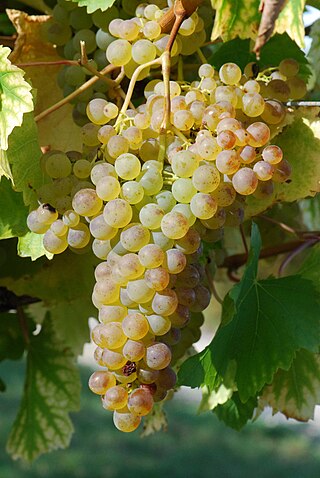
Colombard is a white French wine grape variety that may be the offspring of Chenin blanc and Gouais blanc. This makes the grape the sibling of the Armagnac Meslier-Saint-François and the nearly extinct Cognac grape Balzac blanc.
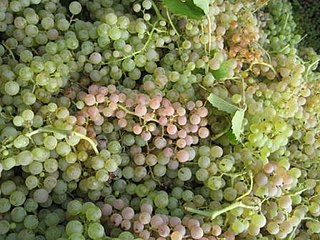
Garganega is a variety of white Italian wine grape widely grown in the Veneto region of North East Italy, particularly in the provinces of Verona and Vicenza. It is Italy's 6th most widely planted white grape. It forms the basis of Venetian white wine Soave and is also a major portion of the blend used to make Gambellara.

Baco blanc or Baco 22A is a French-American hybrid grape variety. It is a cross of Folle blanche and the Noah grape, created in 1898 by the grape breeder François Baco. Folle blanche is its Vitis vinifera parent. Noah, its other parent, is itself a cross of Vitis labrusca and Vitis riparia.

Verdicchio is a white Italian wine grape variety grown primarily in the Marche region of central Italy. The name Verdicchio derives from verde and refers to the slight green/yellow hue that wines made from the grape can have.

Armagnac is a distinctive kind of brandy produced in the Armagnac region in Gascony, southwest France. It is distilled from wine usually made from a blend of grapes including Baco 22A, Colombard, Folle blanche and Ugni blanc, traditionally using column stills rather than the pot stills used in the production of cognac, which is made predominantly from ugni blanc grapes. The resulting spirit is then aged in oak barrels before release. Production is overseen by the Institut national de l'origine et de la qualité (INAO) and the Bureau National Interprofessionel de l'Armagnac (BNIA).

Italian wine is produced in every region of Italy. Italy is the world's largest producer of wine, with an area of 702,000 hectares under vineyard cultivation, and contributing a 2013–2017 annual average of 48.3 million hl of wine. In 2018 Italy accounted for 19 per cent of global production, ahead of France and Spain. Italian wine is both exported around the world and popular domestically among Italians, who consume an average of 42 litres per capita, ranking fifth in world wine consumption.

Soave is a dry white Italian wine from the Veneto region, in northeast Italy, principally around the city of Verona. Within the Soave region are both a denominazione di origine controllata (DOC) zone and, since 2001, a denominazione di origine controllata e garantita (DOCG) designation known as Soave Superiore, with both zones being further sub-divided into a general and Classico designation for the wines produced in the heartland of the Soave region, around the sloping vineyards of Verona.

Pineau des Charentes, is a regional aperitif of western France, made in the départements of Charente, Charente-Maritime, and Dordogne. While popular within its region of production, it is less well known in other regions of France and somewhat uncommon abroad.

Vidal blanc is a white hybrid grape variety produced from the Vitis vinifera variety Ugni blanc and another hybrid variety, Rayon d'Or. It is a very winter-hardy variety that manages to produce high sugar levels in cold climates with moderate to high acidity.
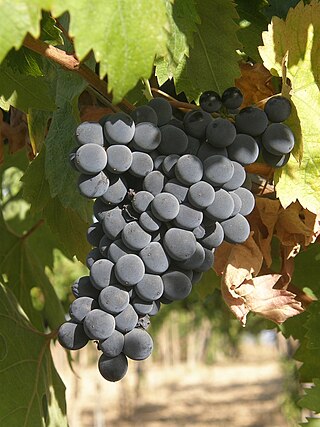
Montepulciano is a red Italian wine grape variety that is most noted for being the primary grape behind the DOCG wines Colline Teramane Montepulciano d'Abruzzo and Offida Rosso; and the DOC wines Montepulciano d'Abruzzo, Rosso Conero, and Rosso Piceno Superiore.

Gros Manseng is a white wine grape variety that is grown primarily in South West France, and is part of the Manseng family. It produces dry wines in the Jurançon and Béarn regions of Southwest France. In Gascony it is permitted in the Pacherenc du Vic-Bilh Appellation d'origine contrôlée (AOC), in the Côtes de Gascogne and in the Floc de Gascogne.
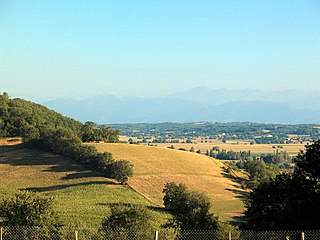
Côtes de Gascogne is a wine-growing district in Gascony producing principally white wine. It is mainly located in the département of the Gers in the former Midi-Pyrénées region, and it belongs to the wine region South West France. The designation Côtes de Gascogne is used for a Vin de Pays produced in the Armagnac area. The decree of 13 September 1968 created the difference between a Vin de Pays and simpler table wine, the so-called Vin de table. The designation Côtes de Gascogne obliges the producers to respect the stricter rules and production standards, which were adopted with the decree of 25 January 1982.
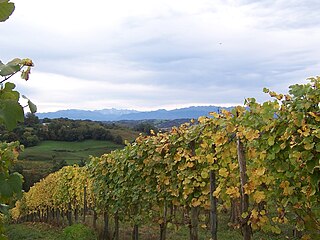
South West France, or in French Sud-Ouest, is a wine region in France covering several wine-producing areas situated respectively inland from, and south of, the wine region of Bordeaux. These areas, which have a total of 16,000 hectares of vineyards, consist of several discontinuous wine "islands" throughout the Aquitaine region, and more or less to the west of the Midi-Pyrénées region.

The Floc de Gascogne is a regional apéritif from the Côtes de Gascogne and Armagnac regions of Sud-Ouest wine region of France. It is a vin de liqueur fortified with armagnac, the local brandy. It has had Appellation d'origine contrôlée status since 1990. Elsewhere in France analogous drinks are made.

Bombino bianco is a white Italian wine grape variety planted primarily along Italy's Adriatic coast line, most notably in Apulia. The vine is prone to high yields and often produces neutral flavor wines. The grape is known under many synonyms throughout Italy including Debit and Pagadebit, names which came from the grape's reputation for being a high yielding and reliable crop for vineyard owners to grow that would assure them that on each vintage they could pay off their debts.

Abruzzo is an Italian wine region located in the mountainous central Italian region of Abruzzo along the Adriatic Sea. It is bordered by the Molise wine region to the south, Marche to the north and Lazio to the west. Abruzzo's rugged terrain, 65% of which is mountainous, help to isolate the region from the winemaking influence of the ancient Romans and Etruscans in Tuscany but the area has had a long history of wine production.
Merlot blanc is a white French wine grape variety that came from a natural crossing of the Bordeaux wine grape Merlot and the Cognac grape Folle blanche. The grape is distinct from Merlot gris which is a pink-skinned color mutation of the red wine grape Merlot and is sometimes used in vin gris and rosé wines. Plantings of Merlot blanc were first discovered in 1891 but cuttings of the vine have not been widely propagated and the variety is very rare. It is not used to make the sweet White Zinfandel-style wine White Merlot that is made by some California wine producers. Those wines are made from a saignee of red Merlot wine.
Rossola nera is a red Italian wine grape variety that has been growing in the Valtellina region of Lombardy since at least the 17th century. In 2004 DNA profiling determined that the grape has a parent-offspring relationship with the Piedmont wine grape Nebbiolo though which variety is the parent and which is the offspring is not yet clear. However, most ampelographers believe that Nebbiolo is likely the parent variety since written records in Piedmont have noted Nebbiolo being grown since at least the 13th century.


















